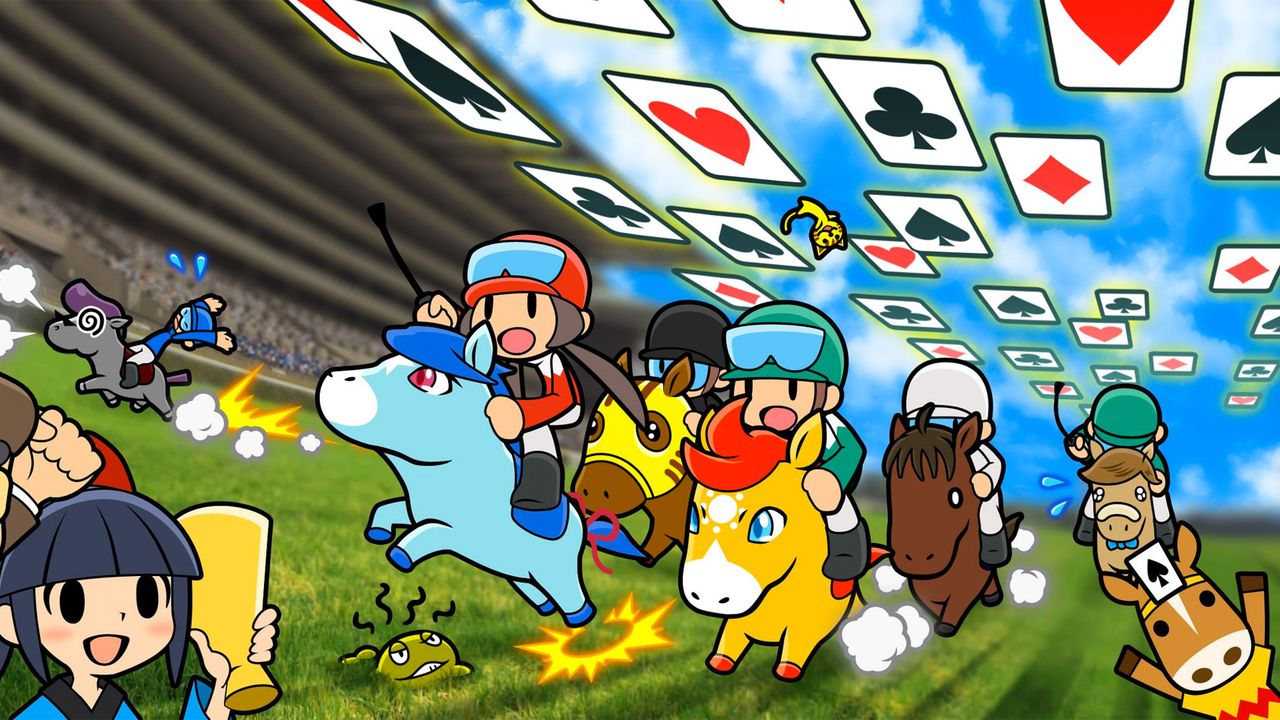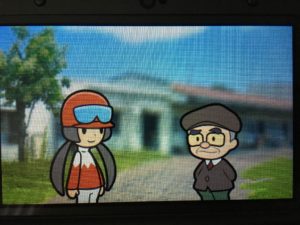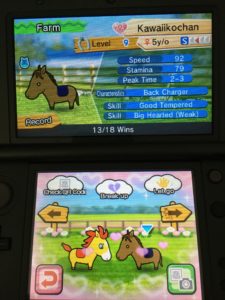It’s usually the games you love – or the games that are really, really bad – that are the easiest to write about. When you’re singing praise, the words seem to flow effortlessly from your pen – and the same goes for when you’re telling everyone about a phenomenal piece of hot garbage.
But Pocket Card Jockey for the 3DS? Hoo boy. I mean, how do you even begin to sell this concept of horse-racing sim solitaire to people? That sounds like the most aggressively boring thing on the planet. In actuality, though, it’s an amazingly complex and deep game! …with a huge mess of intertwining game systems that sounds like complete gibberish if you try to describe them rather than showing them.
But by god, I’m gonna try. Because you know what? Pocket Card Jockey is already one of the best games released in 2016. No horsin’ around.
Pocket Card Jockey, or Solitaiba as it’s called in Japan (with a pun that’s really stretching it), is one of Game Freak’s occasional non-Pokemon offerings. Ever since the world-beloved franchise debuted 20 years ago, it’s where most of Game Freak’s time and energy has gone – to the disappointment of us who remember Game Freak’s older classics. Sure, Pikachu and pals are fun, but Game Freak used to put out a lot of super-cool stuff: Mendel Palace, Jerry Boy, and Pulseman, to name a few. Every so often, though, they’ve found the time to get something like Drill Dozer out the door, and lately, most of their Not Pokemon games have taken the form of download titles. In the past few years, we’ve had the rather disappointing Harmoknight, the friggin’ awesome Tembo the Badass Elephant, and now Pocket Card Jockey.
It’s worth pointing out that the Solitaiba’s original release in Japan happened all the way back in 2013 – which is why it was such a surprise when it popped up in the latest Nintendo Direct as an upcoming 3DS eShop release. Who knows what motivated Nintendo to greenlight localization (possibly just one of those “hole in the release calendar” types of situations), but am I ever glad they did.
Pocket Card Jockey puts you in the role of either a male or female rookie jockey, who, while trying to ride an ill-tempered horse, has an utterly bizarre near-death experience that appears to transform you into a horse-racing whiz. A whiz who perceives vital elements of the race as a variant of 52-card solitaire, that is.
Over the course of the game, you meet a weird menagerie of various horse owners, fellow jockeys, and other odd personalities. They’re a pretty amusing bunch (my personal favorite is the idol who dresses her horses up like kittens and is a secret history buff), and the goofy story and art (which I think is done by some of the same staff as WarioWare/Rhythm Heaven? Not entirely sure) gives the game a unique personality. Of course, the gameplay alone would be sufficient for that – we’ll get there in a sec – but this weird little world of somewhat unhinged jockeys and horse-owning eccentrics is a delightful one.
So, yes, the game itself. This is where text descriptions starts to get a little tough, but I’ll try my best here.
Basically, each race is divided into three phases. You’ve got the actual solitaire part (which isn’t the Windows Solitaire you’re probably familiar with, but a variant I don’t know the precise name of), you’ve got positioning-on-the-track portions, and then you’ve got the crucial homestretch to the finish line. All of these phases flow into each other, with your actions in one directly having an impact on the next.
There are also numerous key factors to managing your horse. Power determines how far your horse can potentially move during the positioning portions, and can also be converted to Energy. Energy is accumulated during the race, and determines how fast your horse runs in the end stretch. Stamina, meanwhile, is represented with little heart card icons, and helps keep your horse from tiring out towards the end of the race. (It can also be expended in the end stretch for a temporary speed boost, or to push aside other horses). Mood, which is shown on a big button on the bottom screen that looks like a horse face, is how your horse is feeling, which affections the conversion of Power to Energy and how well your horse does what you’re trying to get it to do.
Did you get all that? I know that was a whole bunch of words that sounded like synonyms for each other. Stay with me here.
Okay! So, each race starts off with a simple game of solitaire to reach one of the “Start cards” in the back of the stack. The start card you pull determines how much Power you start off with, so you want to try and pull a stronger one if possible. Unfortunately, you can’t dally for too long – if you don’t pull a card quick, you’re going to wind up in a really crappy position on the course to start off. See, on the racetrack itself, there are areas called “comfort zones.” When your horse runs in these comfort zones, it charges Energy for the end stretch. The better the comfort zone, the more Energy you charge every second, so you want to be in the good ones. Most of the time, anyway.
Once you’re off and running, the game alternates between solitaire and positioning portions. The solitaire game – and how well you do in it – has a direct impact on almost every level of your horse’s performance. By stringing along massive chains of cards, you’ll charge extra Power and improve the horse’s mood. Try and take a card that you can’t, and your horse’s mood will darken. Your ideal goal is to clear the board, which confers a lot of benefits: you get extra Power for each leftover card in the deck, you don’t lose any stamina that turn if you’re in a high-level comfort zone, and, if you’re in the best comfort zone, you under into a crazy super-horse mode where your steed charges Energy extremely fast anywhere on the course, sucks in all bonus items, and can knock away any horse that dares to cross its path. Having a bunch of leftover cards when your deck runs out, however, means that your horse’s mood will worsen – and, in the most dire scenario, your horse will go runaway, dropping Stamina like crazy and moving completely independent of your control. Watch the timer, too – you’ve only got a set amount of time to complete the board!
Once the solitaire portion is finished, you go into the positioning portion. Here, you can draw a line on the 3DS’s bottom screen to determine how you want your horse to move. Movement costs Power, so you can only move as far as your current Power will take you – and if you have some left over, you can convert it to Energy. (Said conversion rate depends on the horse’s mood – better mood, better conversion rate.) There’s a fair bit of strategy to this part: not only do you want to get into a comfort zone and a good position amongst the other horses, you also want to try and collect bonus cards that appear on the track that confer extra EXP, special skill learning, a special dash in the homestretch, and Stamina./mood recovery. You also want to pay attention to where your horse is running, because while you’ll save Stamina by running near the inside wall of the course, you’ll also wind up getting a much more difficult solitaire board. In fact, running in higher level comfort zones gives you harder boards in general, so if your horse is getting in a pissy mood, you might opt to step outside for a turn and try to calm it down a bit, as there’s nothing that will completely screw you over harder than a horse going runaway.
The solitaire->positioning->more cards cycle repeats until you enter the final stretch. (Depending on the race length, your horse may or may not reach its “Peak Time,” where it can charge additional Energy during a solitaire game.) These last few fifteen seconds or so is where all your hard work in card-taking and positioning all pays off (or goes horribly wrong). If you have a solid combination of a strong horse, good solitaire play, adequate Stamina, lots of Energy, and you’re not stuck behind a giant herd of everyone else’s big dumb animals, you probably have a solid shot at winning! But even if you screwed up a bit along the way, some things can help you eke out victory by a nose: stamina and bonus cards can be expended for speed boosts to help you push away other horses, and if your horse is feeling chipper, you can maneuver them to completely block off whoever might be creeping up behind you.
Yeah, like I said, this game is deceptively complex, and the way the various game systems intertwine is exceptionally well designed. Everything flows into each other so naturally that you really have to be careful and pay attention every step of the way, and the second-to-second decision-making is surprisingly intense. When you pull off a difficult victory, you really feel like you earned that trophy, goddammit.
But there’s even more to it!
Horses start their racing careers at two years of age, and in “Growth Mode,” you raise them until they’re age four. During these two years of races, you work to improve your horse’s stats, raising their levels and earning special skills. Since EXP earned is tied to leftover stamina at race’s end, you often find yourself facing the difficult choice of “do you try to push and win this race” against “do I just accept this loss and instead get some better stats to win later.” See, once your horse hits age four, its stats and skills are locked, and it moves to the game’s “Mature Mode.” There, you can play as a fully aged horse competing in some of the game’s most grueling races… and, since your horse is fully grown, you don’t have to fear going all-out when you need to. However, once your horse loses three times in Mature Mode, they’ll go off to the farm to breed. I’m still trying to figure out the ins and outs of breeding: things like win/loss ratio, current level, and having similar Peak Times and trophies won all seem to factor into the quality of the foals produced. (Also, as in real life, inbreeding is possible but bad bad bad!)
Jeez, I’ve written 1700 words about this and I haven’t even mentioned stuff like the special skills you can learn, or the items, or how certain horse owners have really funky-looking steeds, or the sometimes hilarious photos that appear when you take first in crucial races, or the whole weirdness with collecting puzzle pieces. This game has a lot of meat to it, and every time I boot it up, I’m glued to my console for several races at a time. There are a few complaints to be lobbied against it: luck does tend to play a factor at times, from getting a really bad board/deck combination to having shithead horses you didn’t see knock you out of comfort zones, costing you precious Stamina. You can do things to play it safer and mitigate some of the luck-based issues, but even those have drawbacks. Sometimes, though, you really just can’t win. As the in-game advice horse says, the racing world can be a cruel one.
The other issue is… well, given that humongous block of text up there, you can probably tell that the game has a bit of a learning curve. It’s not quite as bad as it sounds – the game has a bucketload of tutorials, and it’s easier to get a grasp on things from playing rather than reading – but it’s definitely there, and will probably turn a few folks off. Try and stick with it, though! The game’s super satisfying once it “clicks” and you see how everything works together in a giant, card-fueled horse ecosystem.
Pocket Card Jockey is one of the best games I’ve played yet this year. I’m glad somebody at Nintendo made the decision to greenlight this for localization despite its inherent strangeness, because wow, is it ever a fun and engaging title. Hopefully it’ll sell well and spur more of this sort of output from Game Freak during Pokemon development downtimes. Between this and Tembo, there’s a lot of amazing ideas we still have yet to see from Satoshi Tajiri’s house of gaming love.
Meanwhile, I’ll be debating whether it’s a good idea to blow $20,000 on a stupid carrot.





I know this is late but I recently got into PCG. So in case you’re still wondering, the variant of solitaire used in the game is Golf Solitaire